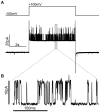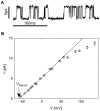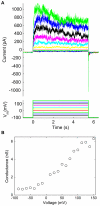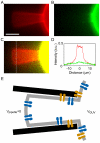Functional reconstitution of a voltage-gated potassium channel in giant unilamellar vesicles
- PMID: 21998666
- PMCID: PMC3188570
- DOI: 10.1371/journal.pone.0025529
Functional reconstitution of a voltage-gated potassium channel in giant unilamellar vesicles
Abstract
Voltage-gated ion channels are key players in cellular excitability. Recent studies suggest that their behavior can depend strongly on the membrane lipid composition and physical state. In vivo studies of membrane/channel and channel/channel interactions are challenging as membrane properties are actively regulated in living cells, and are difficult to control in experimental settings. We developed a method to reconstitute functional voltage-gated ion channels into cell-sized Giant Unilamellar Vesicles (GUVs) in which membrane composition, tension and geometry can be controlled. First, a voltage-gated potassium channel, KvAP, was purified, fluorescently labeled and reconstituted into small proteoliposomes. Small proteoliposomes were then converted into GUVs via electroformation. GUVs could be formed using different lipid compositions and buffers containing low (5 mM) or near-physiological (100 mM) salt concentrations. Protein incorporation into GUVs was characterized with quantitative confocal microscopy, and the protein density of GUVs was comparable to the small proteoliposomes from which they were formed. Furthermore, patch-clamp measurements confirmed that the reconstituted channels retained potassium selectivity and voltage-gated activation. GUVs containing functional voltage-gated ion channels will allow the study of channel activity, distribution and diffusion while controlling membrane state, and should prove a powerful tool for understanding how the membrane modulates cellular excitability.
Conflict of interest statement
Figures








Similar articles
-
Reconstitution of a transmembrane protein, the voltage-gated ion channel, KvAP, into giant unilamellar vesicles for microscopy and patch clamp studies.J Vis Exp. 2015 Jan 22;(95):52281. doi: 10.3791/52281. J Vis Exp. 2015. PMID: 25650630 Free PMC article.
-
A simple method for the reconstitution of membrane proteins into giant unilamellar vesicles.J Membr Biol. 2010 Feb;233(1-3):85-92. doi: 10.1007/s00232-010-9227-8. Epub 2010 Feb 5. J Membr Biol. 2010. PMID: 20135103
-
Membrane shape modulates transmembrane protein distribution.Dev Cell. 2014 Jan 27;28(2):212-8. doi: 10.1016/j.devcel.2013.12.012. Dev Cell. 2014. PMID: 24480645 Free PMC article.
-
Protein Reconstitution Inside Giant Unilamellar Vesicles.Annu Rev Biophys. 2021 May 6;50:525-548. doi: 10.1146/annurev-biophys-100620-114132. Epub 2021 Mar 5. Annu Rev Biophys. 2021. PMID: 33667121 Review.
-
The voltage-sensor structure in a voltage-gated channel.Trends Biochem Sci. 2005 Apr;30(4):166-8. doi: 10.1016/j.tibs.2005.02.006. Trends Biochem Sci. 2005. PMID: 15817390 Review.
Cited by
-
Atomistic study of lipid membranes containing chloroform: looking for a lipid-mediated mechanism of anesthesia.PLoS One. 2013;8(1):e52631. doi: 10.1371/journal.pone.0052631. Epub 2013 Jan 2. PLoS One. 2013. PMID: 23300982 Free PMC article.
-
Formation of Giant Unilamellar Proteo-Liposomes by Osmotic Shock.Langmuir. 2015 Jun 30;31(25):7091-9. doi: 10.1021/acs.langmuir.5b01173. Epub 2015 Jun 15. Langmuir. 2015. PMID: 26038815 Free PMC article.
-
Microfluidic-Derived Detection of Protein-Facilitated Copper Flux Across Lipid Membranes.Anal Chem. 2022 Aug 30;94(34):11831-11837. doi: 10.1021/acs.analchem.2c02081. Epub 2022 Aug 15. Anal Chem. 2022. PMID: 35969432 Free PMC article.
-
Fusion Pore Formation Observed during SNARE-Mediated Vesicle Fusion with Pore-Spanning Membranes.Biophys J. 2020 Jul 7;119(1):151-161. doi: 10.1016/j.bpj.2020.05.023. Epub 2020 Jun 2. Biophys J. 2020. PMID: 32533941 Free PMC article.
-
Endoplasmic reticulum phospholipid scramblase activity revealed after protein reconstitution into giant unilamellar vesicles containing a photostable lipid reporter.Sci Rep. 2021 Jul 13;11(1):14364. doi: 10.1038/s41598-021-93664-0. Sci Rep. 2021. PMID: 34257324 Free PMC article.
References
-
- Hille B. Ion Channels of Excitable Membranes (3rd Edition) Sunderland: Sinauer Associates; 2001.
-
- Marban E. Cardiac channelopathies. Nature. 2002;415:213–8. - PubMed
-
- Ryan DP, Placek LJ. Episodic neurological channelopathies. Neuron. 2010;68:282–292. - PubMed
-
- Kullmann DM. Neurological channelopathies. Annu Rev Neurosci. 2010;33:151–172. - PubMed
-
- Lai HC, Jan LY. The distribution and targeting of neuronal voltage-gated ion channels. Nat Rev Neurosci. 2006;7:548–562. - PubMed
Publication types
MeSH terms
Substances
Grants and funding
LinkOut - more resources
Full Text Sources
Other Literature Sources

